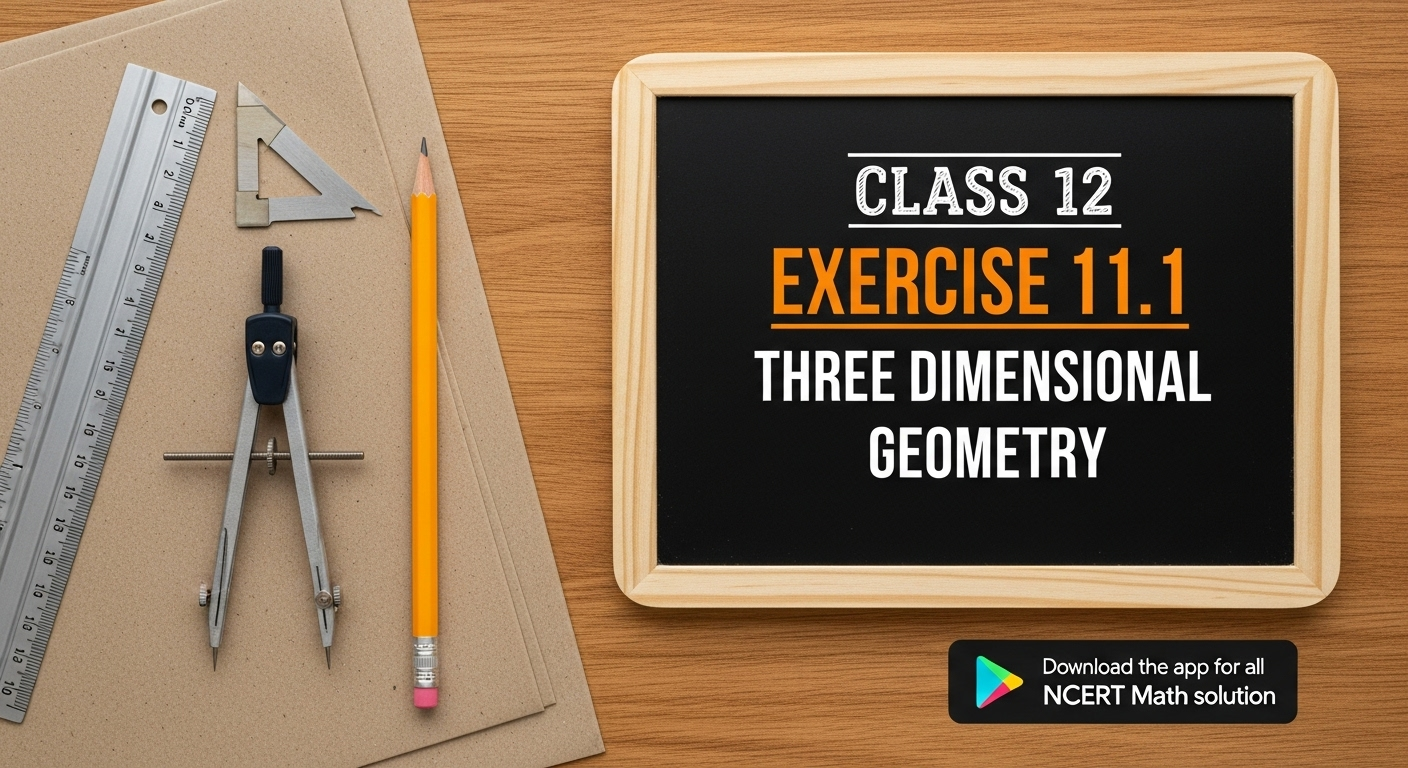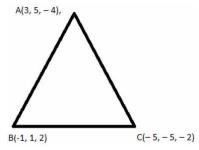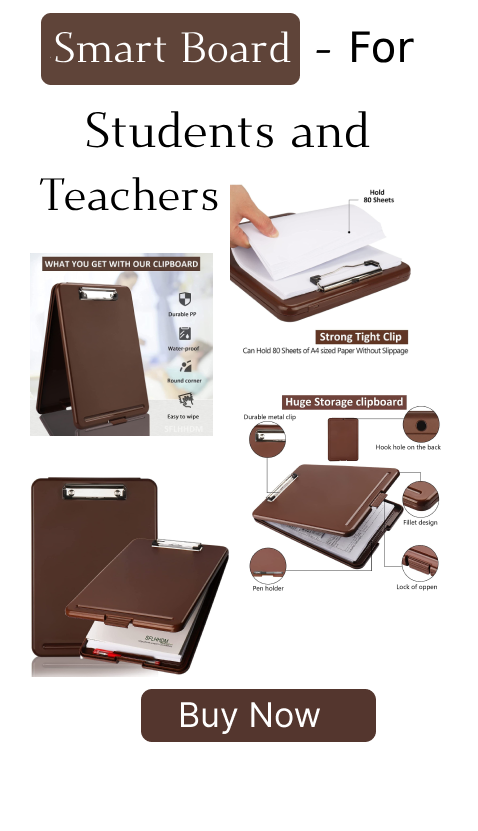Ex 11.1 class 12 maths ncert solutions | class 12 maths exercise 11.1 | class 12 maths ncert solutions chapter 11 exercise 11.1 | exercise 11.1 class 12 maths ncert solutions | class 12 maths chapter 11 ncert solutions | class 12 chapter 11 maths ncert solutions | ncert solutions for class 12 maths ch 11 | ncert solutions for class 12 maths chapter 11 | three dimensional geometry class 12 ncert solutions
Looking to master Three Dimensional Geometry with confidence? The Class 12 Maths NCERT Solutions Chapter 11 Exercise 11.1 provides a solid foundation for understanding direction cosines, direction ratios, and the basics of 3D geometry. Whether you’re searching for Class 12 Maths Exercise 11.1, Exercise 11.1 Class 12 Maths NCERT Solutions, or complete NCERT Solutions for Class 12 Maths Chapter 11, this resource offers clear, concise, and exam-oriented explanations. Perfectly aligned with CBSE patterns, the Three Dimensional Geometry Class 12 NCERT Solutions are designed to make even the toughest concepts simple and scoring.

class 12 maths exercise 11.1 || class 12 chapter 11 maths ncert solutions || three dimensional geometry class 12 ncert solutions || ncert solutions for class 12 maths ch 11 || class 12 maths ncert solutions chapter 11 exercise 11.1 || ex 11.1 class 12 maths ncert solutions || class 12 maths chapter 11 ncert solutions || ncert solutions for class 12 maths chapter 11 || exercise 11.1 class 12 maths ncert solutions
EXERCISE 11.1
1. If a line makes angles \( 90^{\circ}, 135^{\circ}, 45^{\circ} \) with the \( \mathrm{x}, \mathrm{y} \) and z-axes respectively, find its direction cosines.
Answer
Let the direction cosines of the line making \( \angle \alpha \) with x-axis, \( \beta \) - with y-axis and \( \gamma \) - with z-axis are \( l, \mathrm{~m} \) and n
\( \Rightarrow l=\cos \alpha, \mathrm{m}=\cos \beta \) and \( \mathrm{n}=\cos \gamma \)
Here \( \alpha=90^{\circ}, \beta=135^{\circ} \) and \( \gamma=45^{\circ} \)
So direction cosines are
\( l=\cos 90^{\circ}=0 \)
\( m=\cos 135^{\circ}=\cos \left(180^{\circ}-45^{\circ}\right)=-\cos 45^{\circ}=\frac{-1}{\sqrt{2}} \)
\( \mathrm{n}=\cos 45^{\circ}=\frac{1}{\sqrt{2}} \)
\( \Rightarrow \) Direction cosines of the line \( 0, \frac{-1}{\sqrt{2}}, \frac{1}{\sqrt{2}} \)
2. Find the direction cosines of a line which makes equal angles with the coordinate axes.
Answer
Let the direction cosines of the line making \( \angle \alpha \) with x-axis, \( \beta \) - with y-axis and \( \gamma \) - with z-axis are \( l, \mathrm{~m} \) and n
\( \Rightarrow l=\cos \alpha, \mathrm{m}=\cos \beta \) and \( \mathrm{n}=\cos \gamma \)
Here given \( \alpha=\beta=\gamma \) (line makes equal angles with the coordinate axes) \(\ldots(1) \)
Direction Cosines are
\( \Rightarrow l=\cos \alpha, \mathrm{m}=\cos \beta \) and \( \mathrm{n}=\cos \gamma \)
We have
\( l^{2}+\mathrm{m}^{2}+\mathrm{n}^{2}=1 \)
\( \cos ^{2} \alpha+\cos ^{2} \beta+\cos ^{2} \gamma=1 \)
From 1 we have
\( \cos ^{2} \alpha+\cos ^{2} \alpha+\cos ^{2} \alpha=1 \)
\( 3 \cos ^{2} \alpha=1 \)
\( \cos \alpha= \pm \sqrt{\frac{1}{3}} \)
The direction cosines are
\( l= \pm \sqrt{\frac{1}{3}}, m= \pm \sqrt{\frac{1}{3}} n= \pm \sqrt{\frac{1}{3}} \)
class 12 maths exercise 11.1 || class 12 chapter 11 maths ncert solutions || three dimensional geometry class 12 ncert solutions || ncert solutions for class 12 maths ch 11 || class 12 maths ncert solutions chapter 11 exercise 11.1 || ex 11.1 class 12 maths ncert solutions || class 12 maths chapter 11 ncert solutions || ncert solutions for class 12 maths chapter 11 || exercise 11.1 class 12 maths ncert solutions
3. If a line has the direction ratios \( -18,12,-4 \), then what are its direction cosines?
Answer
If the direction ratios of the line are \( \mathrm{a}, \mathrm{b} \) and c
Then the direction cosines are \( \frac{a}{\sqrt{a^{2}+b^{2}=c^{2}}}, \frac{b}{\sqrt{a^{2}+b^{2}=c^{2}}}, \frac{c}{\sqrt{a^{2}+b^{2}=c^{2}}} \)
Given direction ratios are \( -18,12 \) and -4
\( \Rightarrow \mathrm{a}=-18, \mathrm{~b}=12 \) and \( \mathrm{c}=-4 \)
\( \sqrt{a^{2}+b^{2}=c^{2}}=\sqrt{(-18)^{2}+12^{2}=(-4)^{2}} \)
\(=\sqrt{324+144+16}\)
\(=\sqrt{484}=22\)
Direction cosines are
\(\frac{-18}{22}, \frac{12}{22}, \frac{-4}{22}=\frac{-9}{11}, \frac{6}{11}, \frac{-2}{11}\)
4. Show that the points \( (2,3,4),(-1,-2,1),(5,8,7) \) are collinear.
Answer
If the direction ratios of two lines segments are proportional, then the lines are collinear.
Given A \( (2,3,4) \), B \( (-1,-2,1) \), C \( (5,8,7) \)
Direction ratio of line joining \( A(2,3,4) \) and \( B(-1,-2,1) \), are
\((-1-2),(-2-3),(1-4)\)
\(=(-3,-5,-3)\)
So \( \mathrm{a}_{1}=-3, \mathrm{~b}_{1}=-5, \mathrm{c}_{1}=-3 \)
Direction ratio of line joining \( B(-1,-2,1) \) and \( C(5,8,7) \) are
\((5-(-1)),(8-(-2)),(7-1)\)
\(=(6,10,6)\)
So \( \mathrm{a}_{2}=6, \mathrm{~b}_{2}=10 \) and \( \mathrm{c}_{2}=6 \)
It is clear that the direction ratios of AB and BC are of same proportions
As
\(\frac{a_{1}}{a_{2}}=\frac{-3}{6}=-2\)
\(\frac{b_{1}}{b_{2}}=\frac{-5}{10}=-2\)
And \( \frac{c_{1}}{c_{2}}=\frac{-3}{6}=-2 \)
Therefore, A, B, C are collinear.
5. Find the direction cosines of the sides of the triangle whose vertices are \( (3,5,-4),(-1,1,2) \) and \( (-5,-5,-2) \).
Answer

The direction cosines of the two points passing through \( \mathrm{A}\left(x_{1}, y_{1}, z_{1}\right) \) and B \( \left(x_{2}, y_{2}, z_{2}\right) \) is given by
\(
\left(x_{2}-x_{1}\right),\left(y_{2}-y_{1}\right),\left(z_{2}-z_{1}\right)
\)
And the direction cosines of the line AB is \( \frac{\left(x_{2}-x_{1}\right)}{\mathrm{AB}}, \frac{\left(y_{2}-y_{1}\right)}{\mathrm{AB}}, \frac{\left(z_{2}-z_{1}\right)}{\mathrm{AB}} \)
Where \( \mathrm{AB}=\sqrt{\left(x_{2}-x_{1}\right)^{2}+\left(y_{2}-y_{1}\right)^{2}+\left(z_{2}-z_{1}\right)^{2}} \)
\(\begin{array}{|l|l|l|}
\hline Here \ \mathrm{A}=(3,5,-4) & \mathrm{B}=(-1,1,2) & \mathrm{C}=(-5,-5,-2) \\
\hline \mathrm{B}=(-1,1,2) & \mathrm{C}=(-5,-5,-2) & \mathrm{A}=(3,5,-4) \\
\hline \text{Direction ratios of AB} & \text{Direction ratios of BC} & \text{Direction ratios of CA} \\
\hline (-1-3),(1-5),(2-(-4)) & (-5+1),(-5-1),(-2-2) & (3+5),(5+5),(-4+2) \\
\hline =-4,-4,6 & =(-4,-6,-4) & =(8,10,-2) \\
\hline \sqrt{\mathrm{AB}}=\sqrt{(68)}=2 \sqrt{17} & \sqrt{\mathrm{BC}}=\sqrt{(68)}=2 \sqrt{17} & \sqrt{\mathrm{CA}}=\sqrt{(168)}=2 \sqrt{42} \\
\hline \text{Direction Cosines of} & \text{Direction Cosines of BC} & \text{Direction Cosines of CA} \\
AB \ \text{are} & \text{are} & \text{are} \\
\frac{-4}{2 \sqrt{17}}, \frac{-4}{2 \sqrt{17}}, \frac{6}{2 \sqrt{17}} , & \frac{-4}{2 \sqrt{17}}, \frac{-6}{2 \sqrt{17}}, \frac{-4}{2 \sqrt{17}} , & \frac{8}{2 \sqrt{42}}, \frac{10}{2 \sqrt{42}}, \frac{-2}{2 \sqrt{42}} , \\
\frac{-2}{\sqrt{17}}, \frac{-2}{\sqrt{17}}, \frac{3}{\sqrt{17}} & \frac{-2}{\sqrt{17}}, \frac{-3}{\sqrt{17}}, \frac{-2}{\sqrt{17}} & \frac{4}{\sqrt{42}}, \frac{5}{\sqrt{42}}, \frac{1}{\sqrt{42}} \\
\hline
\end{array} \)
